Senecio maritimus
Senecio maritimus L.
Family: Asteraceae
Common names: beach senecio, beach groundsel (Eng.); strandhongerblom (Afr.)
Introduction
A somewhat succulent annual, ideally suited to coastal gardens and common along the Western Cape coast, where its bright yellow flowers light up large dune sections. Often growing naturally interspersed with bright purple Senecio elegans, it makes for a stunning display.
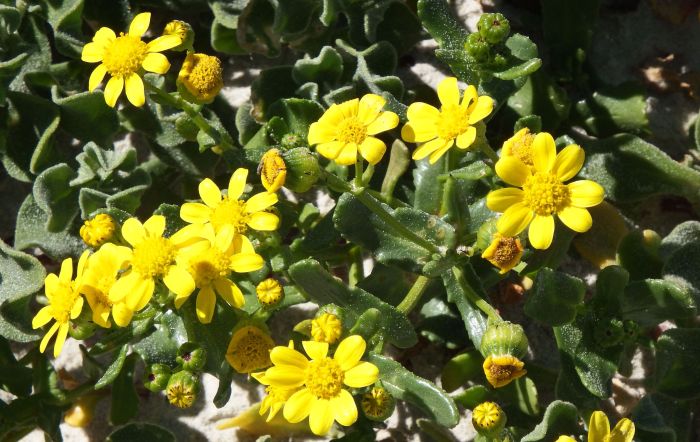
Description
Description
Senecio maritimus is a sprawling, hairless annual of 300 × 400 mm. The slightly fleshy leaves are inversely egg-shaped to oblong, the undersides of the leaves are hairy. The leaf-margins vary between smooth to somewhat toothed. The leaf-bases clasp the stem.
The flowerheads are in laxly branched clusters, each flowerhead consisting of both yellow disc and ray florets. Bracts are in a row with a few ones at the base of the involucre. Flowering is in late winter, spring and early summer, from August to December. Seed collection can be done from late spring, as of October.
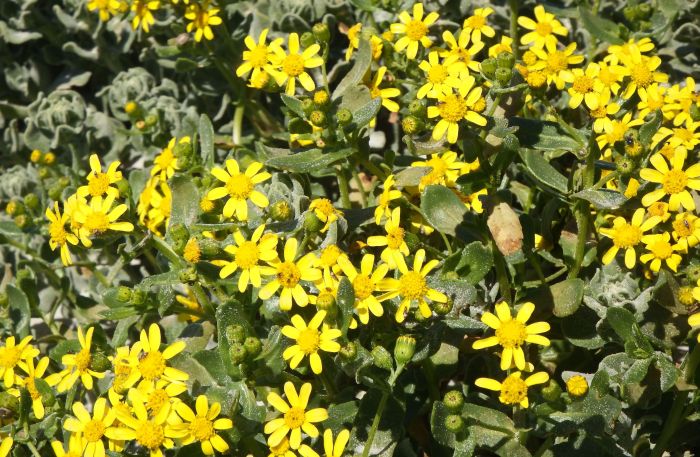
Conservation Status
Status
This species has a Least Concern (LC) status according to the Red List of South African plants website.
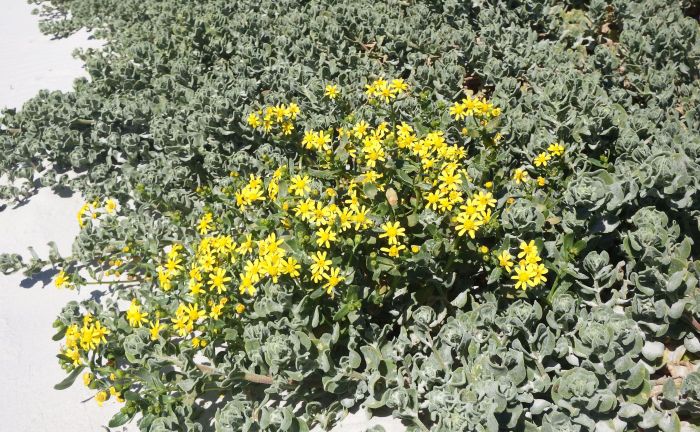
Distribution and habitat
Distribution description
Senecio maritimus is common near the sea shore, growing on coastal dunes and slopes and among rocks in the Western Cape, from Yzerfontein in southern Namaqualand along the coast to the Agulhas area in the Overberg.
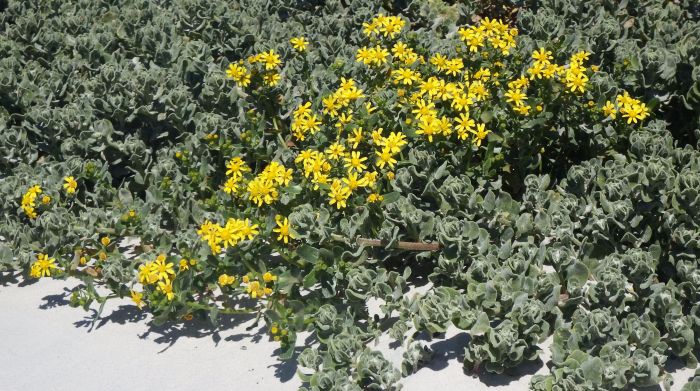
Derivation of name and historical aspects
History
The genus name Senecio is derived from the Latin senex meaning ‘old man’, and alludes to the whitish grey-hairy pappus, which is often typical of this genus. The specific epithet maritimus, meaning ‘of the sea’, is descriptive of the sea-shore habitat.
The genus Senecio is a part of the daisy family or Asteraceae, which is the largest plant family in the world. Senecio is rather cosmopolitan and consists of approximately 1 200 spp. In southern Africa the genus is represented by more than 200 species.
Ecology
Ecology
As with other species of Senecio, most notably the annuals S. arenarius and S. elegans, it is probably pollinated by honey bees.
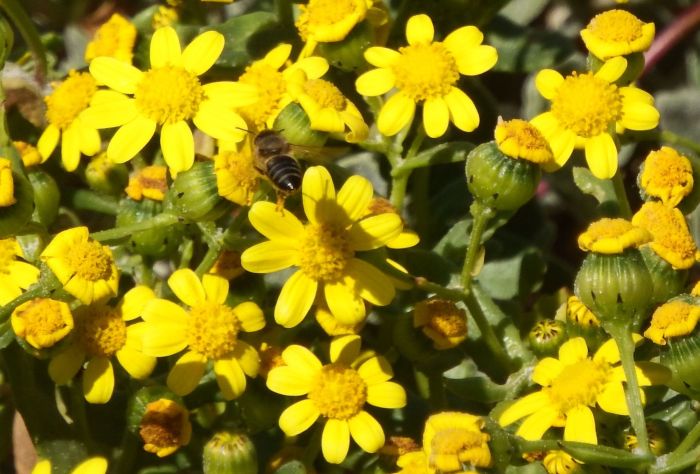
Uses
Use
No medical or cultural uses have been reported. It has the potential to become an excellent garden ornamental.
Growing Senecio maritimus
Grow
At the time of writing, no records exist on the cultivation of this species and, therefore, it cannot be unequivocally stated whether this species is easy to germinate or presents a challenge when it comes to its cultivation. This is especially true for freshly harvested seed for members of the Asteraceae family. In all likelihood, germination will come down to the following: sow the fine seed in a seed-tray filled with a free-draining medium. The seed can also be mixed with some sand, to make handling a bit easier and also to potentially minimize the risk of post-germination fungal-attacks because of too dense sowing.
Keep the sowing medium moist and do not allow to dry out totally. Once germinated, seedlings will be ready for transplanting into the garden once the second set of leaves have appeared. Struggling seedlings can be fertigated by using various organic or inorganic fertilisers, starting with a half strength diluted dosage. Gradually increases the dosages to full strength.
The strandhongerblom will perform well with other annual companion plants, such as: Arctotheca calendula, Dimorphotheca sinuata and D. pluvialis, Felicia heterophylla and F. tenella, Arctotis fastuosa and A. hirsuta, Cleretum bellidiforme, Carpanthea pomeridiana, Oncosiphon grandiflorum and O. suffruticosum, Senecio elegans and S. littoreus, Ursinia anthemoides, U. nana and U. cakilefolia, Cotula duckittiae, Grielum grandiflorum and Nemesia strumosa. Perennials and shrubby companions may include: Arctotis stoechadifolia, Conicosia pugioniformis, Lampranthus aureus, L. bicolor and L. amoenus, Jordaaniella dubia, Cotyledon orbiculata, Salvia aurea (=S.africana-lutea), Carpobrotus edulis and C. acinaciformis, Senecio halimifolius, Coleonema album and C. pulchellum, Agathosma imbricata and A. serpyllacea, Leucospermum prostratum, Metalasia muricata, Othonna dentata, Osteospermum moniliferum (=Chrysanthemoides monilifera), Muraltia spinosa, Pelargonium fulgidum, P. capitatum and P. betulinum, Searsia crenata and S. lucida.
References
- Bell, D. 1999. The process of germination in Australian species. Australian Journal of Botany, 47: 475–517.
- Gess, S.K. & Gess, F.W. 2014. Wasps and bees in southern Africa. SANBI Biodiversity Series 24. South African National Botanical Institute, Pretoria.
- Goldblatt, P & Manning, J. 1996. West Coast. South African Wild Flower Guide 7. Botanical Society of South Africa, Cape Town.
- Johannsmeier, M.F. 2016. Bee plants of South Africa. Strelitzia 37. SANBI, Pretoria.
- Le Roux, A. & Schelpe, T. 1997. Namaqualand. South African Flowering Guide 1. Botanical Society of South Africa, Cape Town.
- Stearn, W. 2002. Stearn's dictionary of plant names for gardeners. Timber Press, Portland, Oregon.
- Trinder-Smith, T. 2006. Wild flowers of Table Mountain. Botanical Society of South Africa, Cape Town
Credits
Roger Oliver
Kirstenbosch National
November 2019
Plant Attributes:
Plant Type: Bi/Annual
SA Distribution: Northern Cape, Western Cape
Soil type: Sandy
Flowering season: Spring, Winter
PH: Acid, Alkaline, Neutral
Flower colour: Yellow
Aspect: Full Sun
Gardening skill: Average
Special Features:
Horticultural zones









Rate this article
Article well written and informative
Rate this plant
Is this an interesting plant?
Login to add your Comment
Back to topNot registered yet? Click here to register.